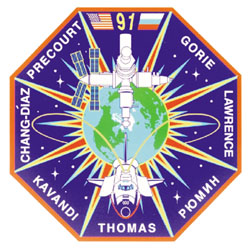
A spaceborne particle physics experiment has come up with new information on the distribution of cosmic-ray particles.
On 2-12 June 1998, the primary payload of NASA’s Space Shuttle Discovery in orbit, 400 km above the Earth, was the Alpha Magnetic Spectrometer (AMS), a sophisticated detector of the type that is normally used in high energy physics laboratories.
During the 10 day voyage, the AMS recorded the tracks of millions of cosmic particles. It was the first time that such a sophisticated physics detector had been deployed in space and the first time so much information on cosmic particles had been collected.
After careful analysis, the data now reveals that subnuclear particles in outer space behave in unexpected ways, especially in how they react to the variation of the Earth’s magnetic field with latitude. They behave as though they are confined in a large magnetic toroid around the Earth’s equator.
Outer space is filled with cosmic-ray particles, the debris being released by subnuclear explosions in distant stars. Viewing these particles from the Earth is difficult because of the shield of the Earth’s atmosphere (the particles are transformed as they crash into atmospheric nuclei). With the AMS, for the first time a major physics experiment was able to view cosmic rays above this atmospheric barrier.
The particle tracks recorded by the AMS show how different cosmic particles respond to the magnetic field of the Earth. In orbit, the AMS was able to scan cosmic rays arriving at different latitudes as the Earth moved. According to previous mappings, this magnetic field was expected to repel less energetic particles arriving around the equator. This terrestrial magnetic repulsion becomes weaker at higher latitudes, so that more particles of lower energy would be seen nearer the North Pole and South Pole.
From the recorded data, the AMS finds an unexpectedly high level of lower energy protons at almost all altitudes, and particularly near the equator. This first deployment of an experiment equipped with a powerful magnet above the Earth’s atmosphere reveals that the distribution of cosmic particles 400 km above the Earth is more complex than had previously been thought.
Even more surprising is that, for protons at less than 6 GeV and in an equatorial arc extending over 4000 km at an altitude of 400 km, the AMS detector sees as many particles moving upwards (away from the Earth) as coming down. It is as though, at this energy, cosmic protons are constrained around the Earth inside a magnetic toroid.
A similar effect is seen with cosmic electrons and their antiparticles positrons except here the energy is approximately 3 GeV. These electrons and positrons are also not primordial they are continuously produced by high-energy cosmic radiation. This should produce as many cosmic positrons as electrons. However, in the equatorial band, the AMS sees about four times as many positrons as electrons! This discrepancy is not understood.
Another puzzle is that in the equatorial toroid, AMS also finds the rare isotope helium-3 rather than the more common helium-4.
The advertised goal of the AMS was to search for signs of cosmic antimatter. In a universe created from a Big Bang that presumably created matter and antimatter in equal amounts, there should be signs of this primordial antimatter, with antinuclei built of antiprotons and antineutrons.
However, our universe appears to be built up entirely of matter and no experiment has ever detected any primordial antimatter. The AMS set out to look for antinuclei above the screen of the atmosphere, but a sample of almost three million cosmic helium nuclei arriving from outer space revealed not one helium antinucleus. AMS sees no primordial antimatter.
AMS, led by Sam Ting of MIT, is a major international collaboration. Important contributions came from groups led by Roberto Battiston in Perugia, Maurice Bourquin in Geneva, Hans Hofer at ETH Zurich, Klaus Luebelsmeyer in Aachen, Antonino Zichichi in Bologna, Shih-Chang Lee in Taipei, Jean-Pierre Vialle in Annecy, Carlos Mana in Madrid, Gaspar Barreira in Lisbon, Jarmo Torsti in Turku and Hesheng Chen in Beijing.








